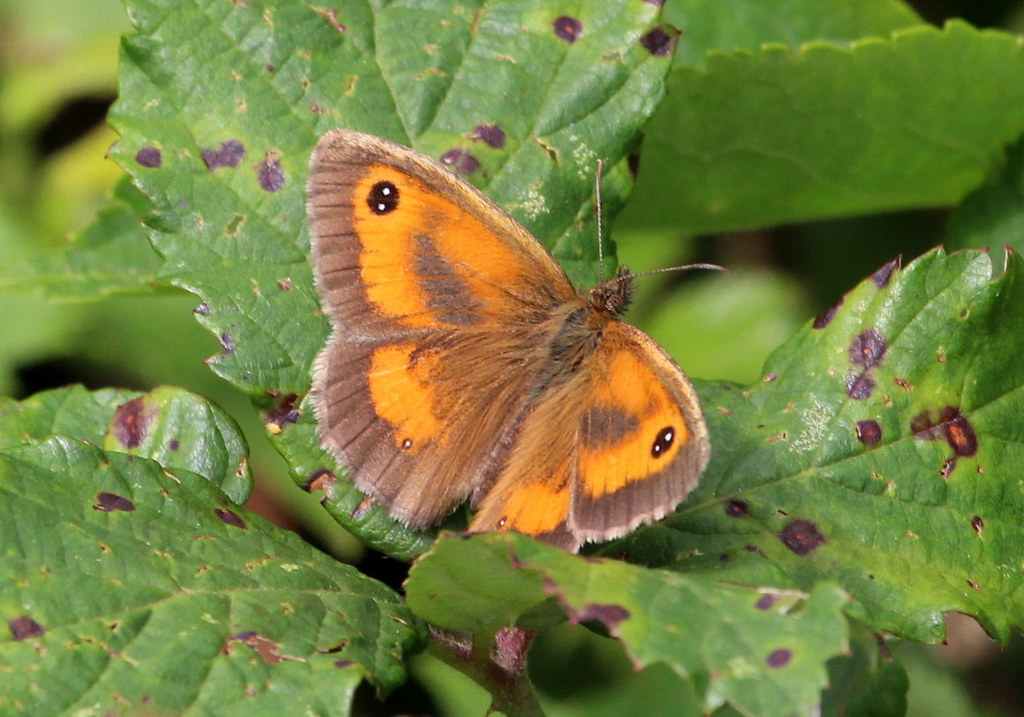No not the dismal rather drab soggy brown of this Autumn because I’m still working through my photos the butterflies of Summer! To help me on my quest I invested in a rather nice book “Butterflies of Britain and Ireland by Michael Easterbrook” Apparently one of the first English books of English butterflies was compiled by Merrett in 1666 which included 21 species with obscure latin descriptions but no names. The collecting of butterflies as a hobby began at the end of the 17th century and the first names were given by a James Petiver.
The browns were a bit more tricky to learn. It took a while, but I think by the end of Summer I could tell my meadow browns from my gatekeepers as long as they weren’t flying off too quickly!
The gatekeeper (sometimes known as the hedge brown) is generally a lovely bright orange and brown, in July there were quite a few around.
(4 Gatekeeper , pyronia tithonus)
When they are perched, its a little harder but it seems the double white eyespot is a bit of a giveaway. I think the one above is a male, which is a little smaller than the female with dark smudges of scent scales across the orange wing. The species was first described by Merrett in 1666
So the other common one flying around is the meadow brown. This one is actually also bigger, so a good identifier in the field, though not so good once I get an image home and have nothing to compare it too. The male really is quite a dull brown, with a tiny eye spot.
(5 Meadow Brown, Maniola Jurtina)
The female is a bit brighter. These butterflies are one of most common, often seen in large numbers. I spotted the most between Crowlink cottages and the South Down’s way, where the meadow fields were teeming with butterflies on a mid Summer stroll. Just an amazing sight, hundreds and hundreds of butterflies – most of them on the move!
Another orange and brown one that I spotted a few times, is the tiny small copper, which favours warm dry sites such as downland and coastal dunes. In 1699 Petiver described it as the “small golden black spotted meadow butterfly”, or later the “small tortoiseshell”
(6 Small copper, lycaena phlaeas)
Another rather lovely orange and brown, is the Wall Brown, spotted once at Seaford head, and once on holiday on the Yorkshire coast. Once common, this butterfly has disappeared from much for central and Southern England. It loves to bask on walls, rocks and in this case bare earth! First described by Petiver as the Golden Marbled Butterfly with black eyes, then later the London Eye.
(7 Wall Brown, lasiommata megera)
The last one of this group, seemed to become more common as the season went on. By September the Small Heath seemed to be only butterfly I spotted up Seaford Head. This tiny butterfly was surprisingly easy to capture with my camera, most obliging!
(8 Small Heath, Coenonympha pamphilus)
I remember in the 80s that brown and orange seemed to be the height of fashion. We had brown wallpaper, and brown and orange curtains. Tasteful! It’s quite out of fashion now of course, but looking at these little beauties I can now quite see the appeal of the combination. It seems that brown is anything but boring.
“I almost wish we were butterflies and liv’d but three summer days – three such days with you I could fill with more delight than fifty common years could ever contain.”
― John Keats, Bright Star:









